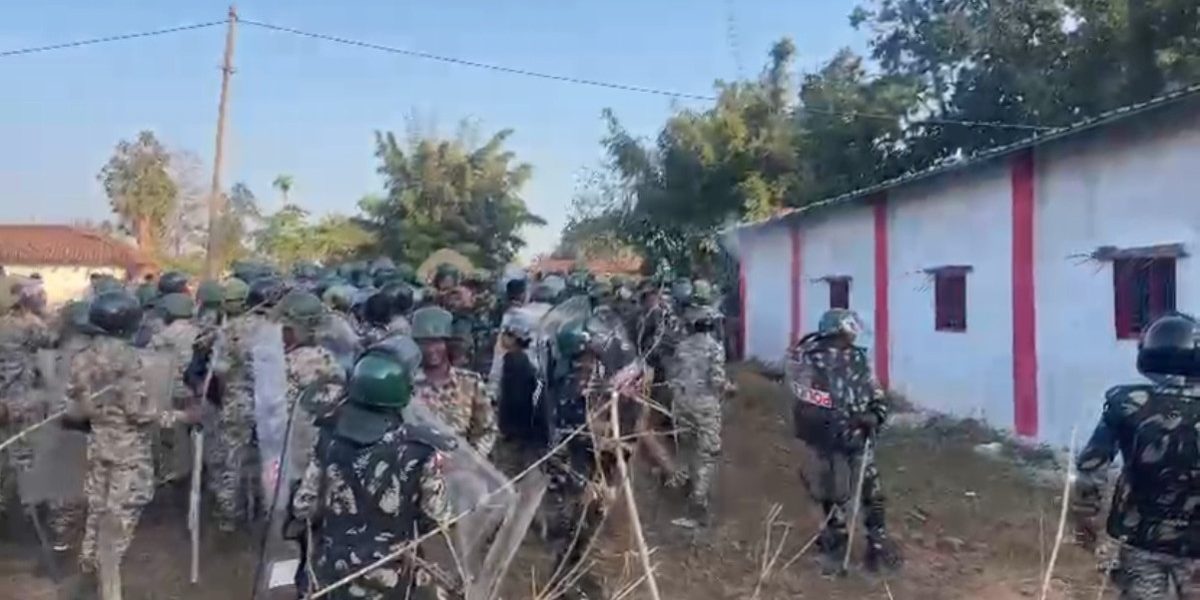
Malgonda Patil, 27, was riding his scooter in Madgaon, Goa, when a bomb he was carrying went off. He was killed instantly. As was his friend Yogesh Naik. His cousin, Rudra Patil, was accused in the blast, although nothing much came of it; he went on the run. The National Investigation Agency (NIA) launched a hunt for him but the trail went cold
That was in 2009.
In September 2015, a special investigation team (SIT) of the Maharashtra police started looking for Patil again after it arrested Sameer Gaikwad for the killing of communist leader Govind Pansare in Mumbai in February that year. The police claimed at the time that Gaikwad and Patil were friends, had started a mobile phone shop together in 2009, in Sangli, Maharashtra.
Around the same time, the Karnataka police and the NIA were also looking for Patil – for his involvement in the killing of academic MM Kalburgi in Dharwad, Karnataka, in August that year. In October, the police found a body in the Belgavi region, between Karnataka and Maharashtra, that they initially suspected was Patil’s. That was proved wrong.
Patil remains at large and not much has been heard of him since; it’s almost as if he dropped off the map.
Patil is from a small village 80 km from Sangli. The last time the extended Patil family saw their sons, Malgonda and Rudra, was in 2009. Malgonda’s father Shivgonda, a 62-year-old farmer claims his son was a member of the Sanatan Sanstha.
“The last time I saw him was before he went to Sanatan Sanstha’s Goa Ashram, a few months before his death. I sent him to Sangli at the age of 16 to study, and I recall that he joined the Sanatan Sanstha. We did not anticipate this would happen.”
Gaikwad and Patil are also members of the Sanatan Sanstha according to the police. Even Naik, the other person killed in the scooter blast in 2009 was a member of the Sanstha, they have claimed.
The Sanstha itself has denied that any of these people are or were its full-time members although it says they may have participated in some of its religious programmes.
“All the allegations against Sanatan Sanstha and Hindu Janajagruti Samiti are baseless…Sanatan Sanstha has no connection with these killings. Due to propaganda by the Communist Party, the misunderstanding about us has been created,” said Chetan Rajhans, national spokesperson of the organisation.
That’s echoed by Gaikwaid, who has been out on bail since 2017, and now lives at his home in Sangli. “I have continued my association with the Sanatan Sanstha. I regularly visit the Sanstha’s ashram in Sangli to meditate, like I used to before I was arrested.”
Still, after Gaikwad’s arrest, the Sanatan Sanstha itself appealed to lawyers to take up his case in court, and as many as 31 lawyers came forward to fight the case, according to the Sanstha’s website.
Sameer Patwardhan, who is the defence lawyer for Gaikwad, Bharat Kurne, Rajesh Bangera, Amit Degwekar (arrested in connection with the murder of journalist Gauri Lankesh), and Virendra Tawde and Sachin Andure (arrested in connection with the murder of Narendra Dabholkar), said he was confident the charges will be dropped.
“In the case Sameer Gaikwad, there is improvement going on day-by-day. I am sure all charges against him will be dissolved. In the case of Virendra Tawde, he has already got bail in connection with Govind Pansare’s case, but not in connection with Narendra Dabholkar case. But there is no evidence to prove he is guilty,” he said.
“I am a follower of the Sanstha as well, even though I am not a full time Sadhak. I like their ideology, and believe in it.”
And soon after he received bail, the Sanstha said on its website, “Fight given for Samir Gaikwad is like a light-house showing direction to ‘Hindutvavadis’. There is a fight between righteousness and unrighteousness.”
Little is known of the Sanatan Sanstha, a Hindu spiritual organization founded in 1999 by Jayant Athavale, although its name has been toted out by investigators over the past few years in cases involving the killing of people perceived to be against the Hindutva philosophy. It’s a list that includes the killing of Kalburgi and Pansare, but also rationalist Narendra Dabholkar in 2013 and journalist Gauri Lankesh in 2017. All the killings have happened in Karnataka and Maharashtra. Much of the coverage of the Sanstha has been based in informal police briefings and case files. There is little that has been proved in a court of law.
Earlier this week, the Karnataka police’s special investigation team looking into the murder of Lankesh said it has forensic evidence to show that Parashuram Waghmare, who has already been arrested, was the person who shot and killed the journalist. Waghmare was arrested in June. The Karnataka SIT has said Waghmare was in touch with Amol Kale, whom it has sought to present as one of the masterminds behind the killing. Kale, it has said, is a member of the Hindu Janajagruthi Samiti (HJS) and is also associated with the Sanatan Sanstha.
Indeed, it would seem as if Lankesh’s killing, and the investigation into it provided vital clues that, if police and federal investigative teams are to be believed, have helped crack all four killings.
Soon after Lankesh’s killing, the Karnataka SIT claimed the weapon used was the same used to kill Kalburgi. Subsequent investigations by the SIT pointed to a group of people in Maharashtra. There are reports that this information came from Kale’s interrogation. The information was passed on to the Maharashtra police’s Anti Terrorism Squad, which, on August 9, arrested Vaibhav Raut, Sharad Kalaskar and Sudhanva Gondhalekar. It also seized weapons and bombs.
A Maharashtra police officer who asked not to be identified said:, “Karnataka SIT shared information with Maharashtra ATS on 10 persons closely linked to Kale.”
While interrogating the people it arrested, the Maharashtra ATS came across the name of Sachin Andure, who was also subsequently arrested. The ATS claims Kalaskar and Andure are Dabholkar’s killers. It also claims both belong to the Sanatan Sanstha, a claim the organization has denied, saying that while they may have participated in its activities, they are not its members.
There could be some substance to this. The Karnataka SIT has previously said that its investigations have pointed to the presence of a shadowy organization that draws its membership from people who have been associated with the Sanatah Sanstha and the HJS. It has arrested eight such individuals, from areas around Sangli, Kolhapur, and Belgavi.
A senior Maharashtra police officer who asked not to be identified seconded this. “Some arrested accused have links to multiple Hindutva organizations at the same time, while those co-accused with him are part of other organizations. It has led us to believe there is an intersection where these groups overlap.”
Fertile ground
From Sangli in Western Maharashtra to Belgavi (earlier Belgaum) in Karnataka, the land is lush and fertile. The average farmer here is better off that his counterpart in most other areas of Maharashtra.
According to the Maharashtra and Karnataka police there are at least 20 to 25 prominent Hindu right wing groups in the belt between Sangli and Belgavi, with a large following of devoted Hindus. To be sure, many of these organizations say they are purely spiritual ones, and most of their followers are simply religious people.
Omkar Shukla, a Miraj based-activist, whose community hall is frequently rented for such programs said, “There are 15 to 18 big groups in this region, and many small ones, which follow the Hindutva ideology. While the Sanatan Sanstha and Hindu Janajagruti Samiti are prominent in Sangli and Miraj, the Sriram Sena is prominent in Belgavi.”
Members of these groups overlap, and are borrowed by other groups to organise large religious programmess and festivals.
Kiran Pol, 37, a seeker or Sadhak — the Sanatan Sanstha given name for its followers — started off by being a member of the Rashtriya Swayamseval Sangh. “I then joined Shivpratisthan Hindustan, and later became a Sadhak,” he says. Pol lives in a Tasgaon, about 25 kilometers from Sangli. He is a well-to-do farmer, and owns a business exporting grapes from his farm in Tasgaon.
Pol said, “We are well to do farmers, but I was unhappy and worried about my life. The Sanatan Sanstha’s teachings taught me to lead a happy life. These are basic teachings of Hinduism, that we miss out on.”
But there’s another, more activist side to these organizations, sometimes led by the belief that Hindus are being persecuted.
For instance, on September 1, the Hindu Janajagriti Samiti, planned a protest in Belgavi following the arrest of one of its members, Bharat Kurne in the Lankesh killing case. It was denied police permission, after a prominent Muslim group applied for permission to protest in the same area at the same time. Kurne too is represented by Patwardhan.
Hrishikesh Gurjar, Belgavi district coordinator of HJS, who planned to lead the protest said, “There is a strong wave against Hindus. All arrests made by the police recently are Hindus. We need to unite and fight this oppression of Hindus. There have been over 60 communal riots in Belgavi over the past two decades, which is proof of our oppression.”
“The entire mission of the Sanatan Sanstha is being carried out on the constitutional path. No agitation is held without prior permission of competent authorities, no vandalism is practised, no stone pelting, ‘Bandhs’ are not observed… violence was never, is never and will never find any place in the mission of the Sanatan Sanstha,” Rajhans said.
This story first appeared in Hindutan Times on September 15, 2018 here.





